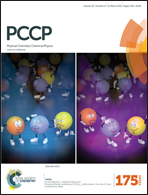The atmospheric oxidation of dimethyl, diethyl, and diisopropyl ethers. The role of the intramolecular hydrogen shift in peroxy radicals†
Abstract
The atmospheric oxidation mechanisms of dimethyl ether (DME), diethyl ether (DEE) and diisopropyl ether (DiPE) are studied by using quantum chemistry and unimolecular reaction theory (RRKM-ME) calculations. For the peroxy radical CH3OCH2O2˙ from DME, a barrier height of ∼85 kJ mol−1 is found for its intramolecular H-shift to ˙CH2OCH2OOH, which can recombine rapidly with the atmospheric O2. RRKM-ME calculations obtain an effective rate of ∼0.1 s−1 at 298 K for the formation of ˙O2CH2OCH2OOH. For similar radicals in DEE and DiPE, effective rates are 1.6 s−1 and 1.1 s−1, respectively. In the atmosphere, these unimolecular reactions are fast enough to compete with the bimolecular reactions with NO and/or HO2, especially when [NO] is low. The fates of radicals after the H-shifts are also examined here. Several subsequent reactions are found to recycle OH radicals. New mechanisms are proposed on the basis of present calculations and are consistent with previous experimental results. In the atmosphere, the routes via H-shifts represent an auto-oxidation of these ethers with no involvement of NOx and therefore no O3 formation, and also a self-cleaning mechanism of organic compounds due to recycling of OH radicals. Some of the end products are highly oxidized with multifunctional groups and high O : C ratios, suggesting their low volatility and potential contribution to secondary organic aerosols.


 Please wait while we load your content...
Please wait while we load your content...